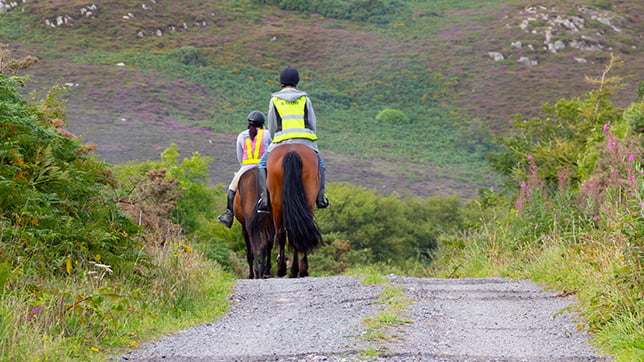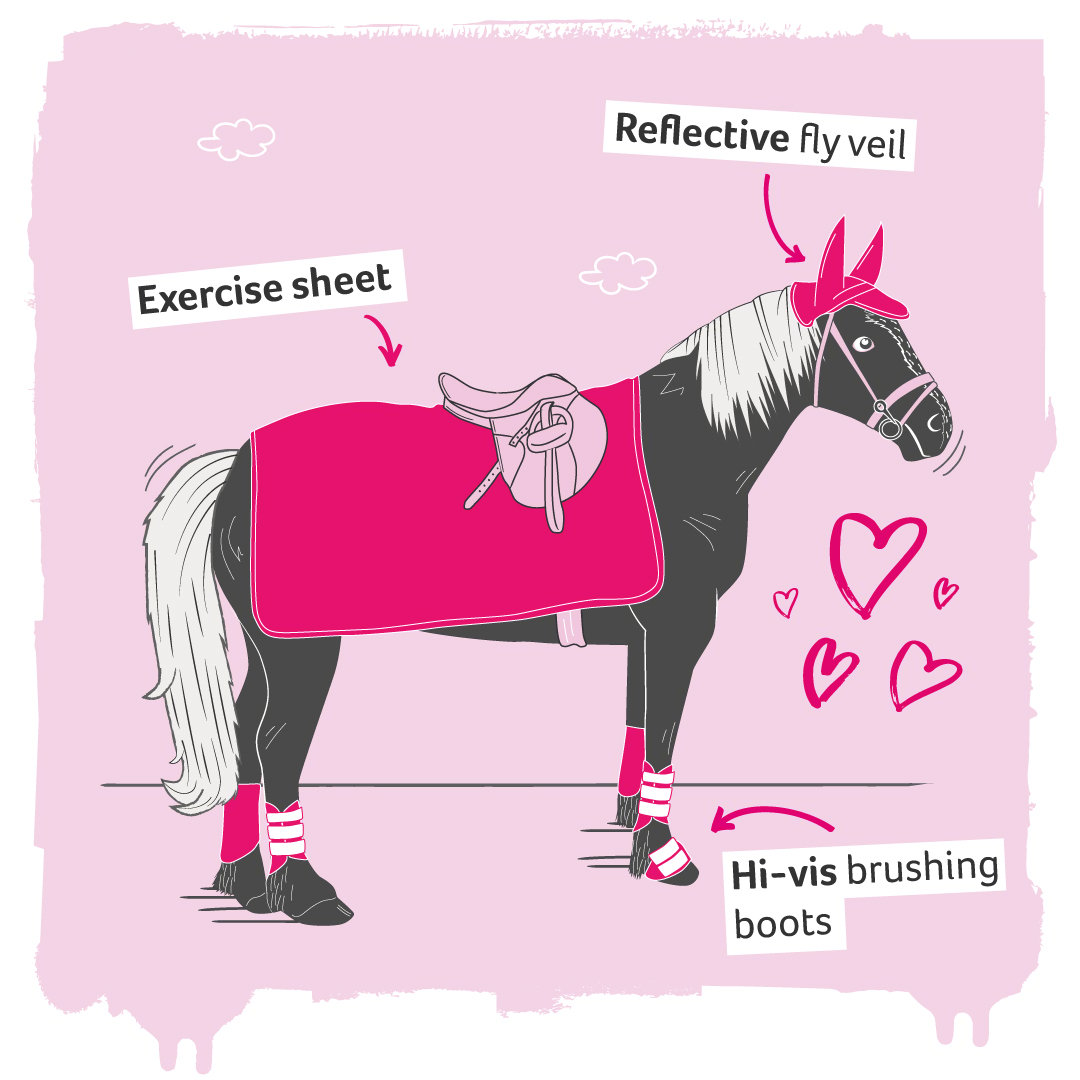5th November 2024
The importance of hi-vis for horse and rider
As owners and riders, we know that whenever we spend time with our horses, safety is key – whether schooling, hacking, or competing. So, it’s important to do all we can to keep our horses, and ourselves, safe.
Being visible while riding, leading, or carriage driving with your horse is especially crucial if you’re using a road. The best way to make sure you’re seen by other road users is by using high visibility equipment – also known as ‘hi-viz’ or ‘hi-vis’.
Read on, to learn more about:
- Hi-vis wear.
- Why hi-vis is essential.
- Whether the colour of your hi-vis equipment makes a difference.
What is hi-vis?
Hi-vis or ‘high visibility’ describes items of clothing and equipment that are fluorescent and/or reflective, e.g. hard hats and tabards.
High visibility wear started life as safety equipment for workers at places like railway lines, factories, and construction sites.
Florescent fabrics glow in reaction to the sun’s UV rays, whereas the reflective qualities of a material allow a garment to reflect light that shines directly at it. To improve the visibility of wearers, hi-vis clothing and equipment often combines both fluorescent and reflective properties.

Why is hi-vis important?
The idea of hi-vis equipment is that it allows the wearer to be seen from a distance – particularly in low-light conditions.
Being seen from a distance allows drivers, motorcyclists, and cyclists additional reaction time to notice horses and their riders, or leaders, and slow down as they approach. As such, improved visibility has been shown to result in a reduced risk of accidents for horses and riders.
For many equestrians, roadwork becomes an essential part of their daily hacking routine, which means a lot of horses and riders may be on the road when visibility is poor. Situations that can cause poor visibility include:
- Low light conditions at dawn and dusk.
- Bad weather, e.g. rain or fog.
- Dense foliage and roadside hedges.
Guidance about hi-vis wear for the equestrian road user is included as part of the Highway Code.
Top tip: Wearing hi-vis while hacking off road also improves the safety of both you and your horse, since you can be seen more easily in case of an accident.
Does the colour of hi-vis wear matter?
There are a few different colours to choose from when buying hi-vis wear for yourself and your horse, though the most popular are yellow, pink, and orange.
Here’s a basic guide for when each hi-vis colour tends to be most and least effective:
Yellow hi-vis
+ Offers brilliant visibility in low-light conditions.
– Less effective when riding past golden fields (corn crops, for example).
Pink hi-vis
+ Provides excellent contrast against darker coat colours (horse and human!).
– May not catch the eye as quickly as yellow in low-light conditions.
Orange hi-vis
+ Great for visibility against green foliage.
– Less effective during autumn, when hedgerows and trees are changing colour.
Top tip: Wearing a combination of hi-vis items in yellow, pink, and orange could help to increase your visibility throughout the seasons!
When choosing hi-vis equipment of any colour, it must conform to the following standards:
- EN ISO 20471:2013 – For professional use, e.g. working with or around horses.
- EN1150 – For non-professional use, e.g. those who are leisure riders.
- EN13356 – For accessories, e.g. riding hat bands, gloves, arm bands, etc.
You can usually find out whether an item conforms to the above standards by checking its label.
Hi-vis items available for horses
Items you should be able to find for your horse that boast reflective properties, and can also be found in a variety of fluorescent colours, include:
- Exercise sheets (available in waterproof, lightweight, and fly sheet styles).
- Leg bands (though reflective brushing boots are available, too!).
- Fly veils (sometimes referred to as ear bonnets).

Hi-vis items available for riders
To stay safe by being seen while exercising your horse (on or off road!), here are a few fluorescent and reflective hi-vis items you might want to consider:
- Tabard or waistcoat.
- Waterproof jacket.
- Riding hat band.
- Gloves.
- Arm bands.
Top tip: If you want to increase your visibility even more, opt for hi-vis kit containing LED lights.
To discover an array of hi-vis products, check out our guide to hi-vis equestrian wear for horses and riders.
What’s your favourite hi-vis colour combination for hacking with your horse? Please let us know via Facebook or Instagram!
Explore other ways to keep your horse happy and safe, by visiting our advice guides on a range of topics, from colic to keeping them cosy in cold weather.
Looking for more horse advice?
Support and advice so that owners and riders can take the very best care of their equine.
Need horse insurance?
Horse insurance can help cover the cost of veterinary treatment if your horse gets injured or falls ill.
